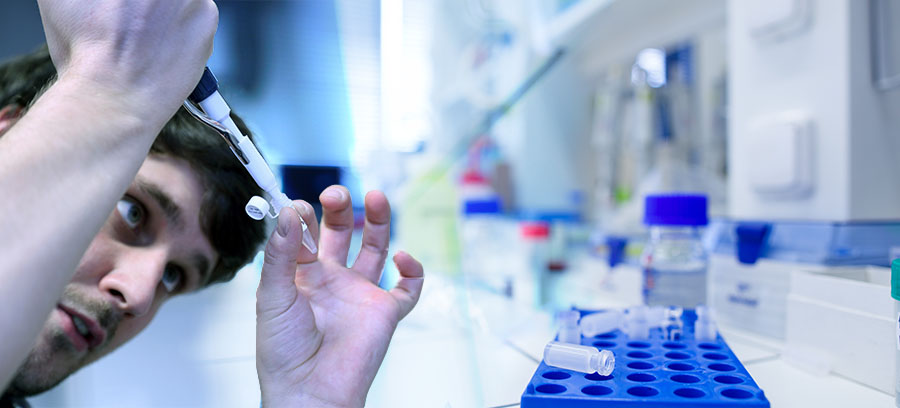Real-time PCR, the advanced level of a standard PCR technique that is used for DNA or RNA quantification in a sample. The number of amplified products of a specific sequence of DNA or RNA can be determined using sequence specific primers. Quantification is possible by measuring the amount of amplified product in real time, at each stage of the PCR cycle. If a particular sequence of DNA or RNA is rich in the sample then amplification can be observed in earlier cycles and if the DNA or RNA sequence is rare, then amplification can be observed in later stages of cycles. Fluorescent probes or fluorescent DNA-binding dyes are being used to quantify the amplified products in a real-time PCR thermal cycler that measure fluorescence [1].
In a standard PCR technique, the amplified DNA or RNA product is determined in an end-point analysis. Whereas, in real-time PCR, the amplified product is measured as the reaction progresses and quantified after each cycle. The qPCR workflow involves; set up of amplification reactions with PCR reagents and specific primers, running of reactions in real-time PCR thermal cycler, and analysis of collected data using proprietary thermal cycler or instrument software. The detection of amplified product is performed by the addition of a fluorescent molecule which yields enhanced fluorescence with the increase of DNA amount. For this purpose, the DNA-binding dyes or fluorescently labeled primers or probes are used. Specialized thermal cyclers which are equipped with fluorescence detectors, used to detect the fluorescence as amplification occurs. The monitored fluorescence is directly proportional to the total amount of amplified product. The major advantage of real-time PCR compare to standard PCR is that the real-time PCR determine the initial amount of template target DNA with high accuracy and sensitivity. The results obtained from real-time PCR can either be qualitative (presence or absence) or quantitative (amount of amplicon). The quantitative real-time PCR also called as qPCR analysis. Moreover, the reactions performed in real-time qPCR, data collection and evaluation all occurs in a unified, closed-tube qPCR system which also reduces the chances of contamination [2]. The real-time qPCR reactions are run for 40 cycles and each cycle represents three major steps including; denaturation (95°C), annealing (based on Tm of the primers), and extension (70-72°C) [1].
The real-time qPCR involves four major phases; linear phase, early exponential phase, exponential phase (log-linear), and plateau phase [3]. The first 10–15 cycles represent the linear phase where PCR reaction just started and the fluorescence emission has not yet increased above the background. The baseline fluorescence is measured at this time. The early exponential phase determines the amount of fluorescence which has reached a threshold level, where it is significantly higher than background levels. The cycle at which this high level of fluorescence achieved is called as Ct or CP. This value represents the initial copy number in the template and is used to measure the experimental results [4]. During the log-linear phase or exponential phase, the reaction reaches at its optimal amplification. Finally, the plateau phase is reached when a limitation in reaction components occurs and the fluorescence intensity is no longer useful to collect data anymore [5].
A real-time PCR detection system composed of a thermal cycler which equipped with an optical detection system in order to measure the fluorescence generated in each amplification cycle. The qTOWER³ is a real-time PCR thermal cycler that guarantees well-founded real-time PCR results as it benefits from peerless temperature control precision in the sample block regardless of the number of samples used. The patented high-performance optics guarantee the outstanding homogeneous excitation and illumination of all individual samples. The key features of this detection method are outstanding high-performance optics as well as excellent temperature uniformity over 96 or up to 384 samples. This cycler can achieve unique flexibility with its proven filter module equipment, which can be freely configured and expanded at any time, and enables up to six-fold multiplexing.
Currently, Jant Pharmacal is offering a special package promotion for the first-time buyers of the qTOWER³ system. It includes 20% off custom pre-plated RT-PCR panels, complimentary IQ/OQ, validation assistance, and more. Click for more information about the qTOWER³ promo.
References
1]Heid, C. A., Stevens, J., Livak, K. J., & Williams, P. M. (1996). Real time quantitative PCR. Genome research, 6(10), 986–994. https://doi.org/10.1101/gr.6.10.986
2] Bustin S. (ed) (2004) A-Z of Quantitative PCR. IUL Biotechnology Series, International University Line, La Jolla, California.
3] Tichopad, A., M. Dilger, G. Schwarz, and M.W. Pfaffl. 2003. Standardized determination of real-time PCR efficiency from a single reaction set-up. Nucleic Acids Res. 31:e122.
4] Marisa L. Wong and Juan F. Medrano. (2005). Real-time PCR for mRNA quantitation. BioTechniques, 39(1), 75-85
5] Bustin, S.A. 2000. Absolute quantification of mRNA using real-time reverse transcription polymerase chain reaction assays. J. Mol. Endocrinol. 25:169–193.


